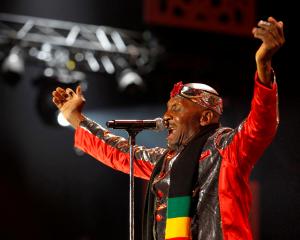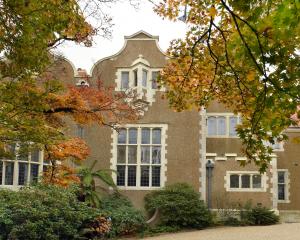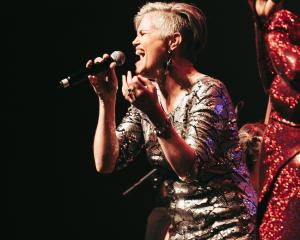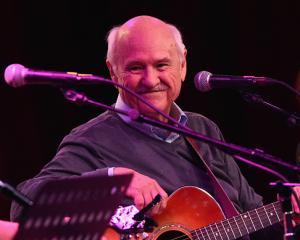This weekend marks the 40th anniversary of Woodstock, the most famous rock festival in the world. Shane Gilchrist explores the event's resonance with Mike Evans, co-editor of a new book on the subject.
Forty years ago, on August 15, 1969, a month after the moon landing and a mere week after Charles Manson's cult members went on their killing spree, another event began to earn headlines amid the news log-jam of the times.
It was anticipated the Woodstock Music and Art Fair, held on Max Yasgur's dairy farm in Bethel, New York, would attract 100,000 people.
Instead, half a million turned up to listen to some of the leading acts of the day, including Jimi Hendrix, Janis Joplin, the Grateful Dead, The Band, Joan Baez, Jefferson Airplane and The Who.
Mike Evans, co-editor of a new book on the subject, Woodstock: three days that rocked the world, was in England at the time, playing saxophone in a band.
The first he knew of the three-day concert was when mainstream media reports filtered across the Atlantic of a near-disaster: mud for miles, sanitation issues, food shortages and massive traffic jams.
Evans, speaking from his London home, says the spirit of the time, a mucking-in despite (or because of) the conditions was a key reason why Woodstock continues to hold such a high place in the folklore of popular culture.
"It certainly wasn't because of the music. Many of those festivals of the time had the same bands," he says, pointing to the first of the "big hippy festivals", the Monterey Pop Festival in 1967.
"There were several others before Woodstock, but I think Woodstock became famous mainly by default.
"Because there were far more people than expected, it descended into chaos . . . [but] because there was this chaos, they actually looked after themselves for three days. It was one great demonstration of that whole peace and love ethos."
A musician on the 1960's rock scene, Evans began writing about popular music in the 1970s.
Since the late '80s he has worked in book publishing, commissioning and editing titles on rock 'n' roll, jazz, and popular culture.
Previous books include The Rock 'N' Roll Age , From Kerouac to Kesey: An Illustrated Journey through the Beat Generation, The Beatles Literary Anthology and Elvis: A Celebration.
Evans began collecting material for Woodstock early in 2008, the project taking him more than a year to complete.
Working with co-editor Paul Kingsbury, a freelance writer and editor specialising in music journalism and the former deputy director of Special Projects for the Country Music Hall of Fame and Museum, he had access to the "massive" archives at the Museum At Bethel Woods, which opened in June last year.
"They had interviewed various people who were there, local people, policemen ... a lot of the quotes from people who were on the ground there were from the archive. We wanted it to have as many first-hand accounts as we could."
Evans and Kingsbury established a three-part structure to the book: "Origins" sets the stage by describing the counterculture of the time, along with the festival's organisation, fundraising, buzz-building tactics, ticket selling and publicity, and site building; "The Event" includes a run-down of each of the 32 acts, in the order they appeared, as well as an examination of fans; and "The Aftermath" focuses on media coverage, follow-up festivals and Woodstock's enduring legacy.
A key theme of the book is the examination of the socio-political context in which Woodstock was held; another reason for the event's resonance.
"The big unifying factor in that counterculture was the anti-Vietnam War movement, because it affected young people in particular.
"The average age of a GI in Vietnam was 19; these were college kids. There was an anger that grew among America's youth, which didn't manifest itself elsewhere in quite the same way. It came to a head in 1969."
Evans says Woodstock attracted a wide cross-section of the counterculture, "alternative society as you'd call it".
Some came to party, others to make a political statement.
Spiritual groups rubbed shoulders with anarchist outfits such as the White Panthers or bus-dwellers the Hog Farmers, called in to help with catering.
However, the main body comprised middle-class white kids.
Reaction among media to the event varied.
The New York Times gave ample room to drug use, traffic problems and food shortages; the day after the festival ended, it ran a finger-wagging editorial castigating organisers and concertgoers alike.
Others, however, preferred to recognise the event as a social phenomenon.
Life magazine presented an eight-page photo feature, while Newsweek saw the event in the context of the counterculture, as a genuinely radical voice in American society.
Evans says the problems of Woodstock actually helped set a template for other festivals.
"Because it was a near-disaster, people learnt a lot of lessons from it.
They didn't anticipate the numbers; they had catered for about 100,000 and half a million turned up.
They didn't take into consideration the road situation, transport, or the fact they were basically in the middle of a field that you could only get to via small country roads.
From there on in, festival organisers began to streamline things.
Of course, by now, it has become much more corporate."
Though two people died at the festival - one from a drug overdose, the other after being run over by a tractor - and 6000 were treated for a range of complaints, including drug-related issues, Woodstock was notable for its lack of violence, Evans says.
In fact, one of the most famous incidents involved The Who's guitarist Pete Townshend, who struck Yippie leader Abbie Hoffman with his instrument when the anarchist attempted to interrupt the British band's set.
It seemed Townshend had little liking for the sentiments of many of the crowd.
Dressed in a white jumpsuit (Evans describes him as looking like he was about to go to a painting job), Townshend had this to say of the festival: "All these hippies wandering about thinking the world was going to be different from that day on . . . what they thought was an alternative society was basically a field full of six-foot-deep mud laced with LSD.
If that was the world they wanted to live in, then f ... the lot of them."
To which The Who's singer, Roger Daltrey (dressed in a tasselled suede jacket more synonymous with the event) replied: "Woodstock was probably the single best show in history. Townshend doesn't like it because he is an idiot."
Others shared Townshend's cynicism: Neil Young refused to allow those filming the event to capture him on camera; he saw it as the beginning of the end: "What effect did Woodstock have on music? That's when the market got big enough for the marketers to realise that they should go for it . . . that was the beginning of rock 'n' roll being used in commercials."
Bob Dylan, who a few weeks later headlined the Isle of Wight festival in Britain, refused to play at Woodstock; by the end of the '60s, he was fed up with the hippies who trekked to his home town of Woodstock, making life miserable for his family.
"Because he had so many hippies trying to park out on his lawn, he put a sign on his gate that read, `if you haven't phoned, you're trespassing'," Evans says.
"It's surprising how many people in the music business were fairly cynical of the whole hippy thing."
Yet perhaps overlooked in the myth of Woodstock are the performances over that weekend.
Reputations were made: Sly Stone and British blues act Ten Years After went from strength to strength following the festival, as did Melanie Safka, an unknown folk singer from Queens, New York, who benefited from a mass match-lighting ceremony on the first night.
Others performed less than impressive sets: members of the Grateful Dead are on record as saying it was the worst gig they'd done.
To be fair to the band, a combination of rain and electrical equipment didn't help, with two members of the group suffering electric shocks.
Janis Joplin's set was also below par, mainly because she was due to play at 8pm but didn't get on stage until midnight, by which time she had consumed a couple of bottles of bourbon.
Key contributors, too, to the endurance of the event were the film and soundtracks that quickly followed.
The documentary Woodstock: Three Days of Peace and Music, directed by Michael Wadleigh and co-edited by Martin Scorsese, hit screens in June 1970.
A box-office success that by 1999 had earned more than $US100 million (as had the soundtrack by the same time), it eventually paid off the debts of Woodstock Ventures, which a year after the festival had recorded a loss of $US1.2 million.
"It certainly saved the people who put on the festival," Evans says.
"Because they had to make it a free event because so many people turned up, they lost loads of money on it initially. They had to pay the artists and fund the whole thing . . .
"It was only because they sold the movie and soundtrack rights that they not only got their money back, but actually made a few million."
• Woodstock: factfile
When: August 15 to August 18, 1969.
Where: Max Yasgur's dairy farm at Bethel, about 200km from New York City.
Attendance: Between 300,000 and 500,000 (organisers had made preparations for 100,000 concertgoers). An estimated 250,000 people never made it to the site.
Revenue (mostly from advance ticket sales): $US1.4 million.
Expenses: $2.7 million.
Initial losses: $1.3 million (eventually recouped, by 1980, through film and soundtrack royalties).
Other points: There were two deaths: one person died from heroin overdose, another run over by a tractor.
There were two births and four miscarriages during the festival.
More than 6000 people were treated for injuries and other complaints.
As well as the initial 18 doctors and 36 nurses, an additional 50 doctors were flown in from New York City on August 16.
It took an average eight hours to drive the 200km from New York City to Bethel; fans walked an average 30km to the site after abandoning their cars.
At its peak, there was a 35km traffic jam along Route 78.
The shortest waiting time between acts was 40 minutes; the longest (excluding rain-enforced delays) was 120 minutes.
36 off-duty New York City policemen were hired, in addition to 150 volunteer police, 100 local sheriffs and 100 state troopers and deputies from 12 counties.
The highest paid performer was Jimi Hendrix ($US18,000, plus $12,000 for subsequent film appearance); the lowest paid was Quill ($375).
Freebies
The Otago Daily Times is offering readers the chance to win one of two Woodstock prize packs featuring the book, Woodstock: three days that rocked the world (Sterling, $79.99, hbk), and a two-disc CD, Woodstock 40, comprising stand-out performances from the 1969 festival.
To be in the draw, write your name, address and daytime phone number on the back of an envelope and send to Woodstock, ODT Features, Response Bag 500011, Dunedin, or email playtime@odt.co.nz with Woodstock in the subject line.
Entries close on Thursday.

















